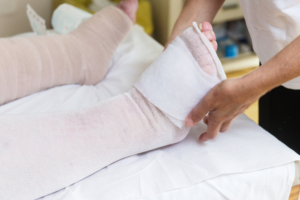Compression Bandaging
For those with a very large limb with soft swelling, compression bandaging is probably the most effective way to reduce your limb size. This does not mean that it is easy!
No firm compression should be applied to a limb with compromised circulation so if poor leg compression is suspected, arterial circulation may need to be checked. This might be done with your GP ordering an arterial doppler. I am able to perform an Ankle Brachial Pressure Index (or a Toe Brachial Pressure Index for diabetics) within the clinic at no extra cost.
Once compression bandaging has been started, most clients feel that the benefits definitely outweigh the burdens. I am always honest about the burdens and benefits of any treatment. You will have extra support if needed during compression bandaging.
The Good
Compression bandaging will soften fibrotic skin and assists in healing of skin affected by chronic oedema. It is probably the most effective treatment for reducing limb oedema. The skin is moisturised and protected before one or two layers of short stretch bandaging is applied to the limb. Bandages are reapplied at least twice a week until the limb oedema is stabilised. Once stable a compression garment is ordered.
The Bad
You will need to purchase the bandages but they are yours to keep.
You may need to wear different shoes or trousers until the bandaging is completed. The bandages will feel hot during summer and you may have disturbed sleeping. You may be advised to wait until the cooler months before bandaging is commenced.
The Ugly
Unless you are an expert in waterproofing limbs, you will not have a shower until the permanent garment has arrived! Don’t worry too much and you can have a ‘bird bath’ (bathroom sink and face washer).



